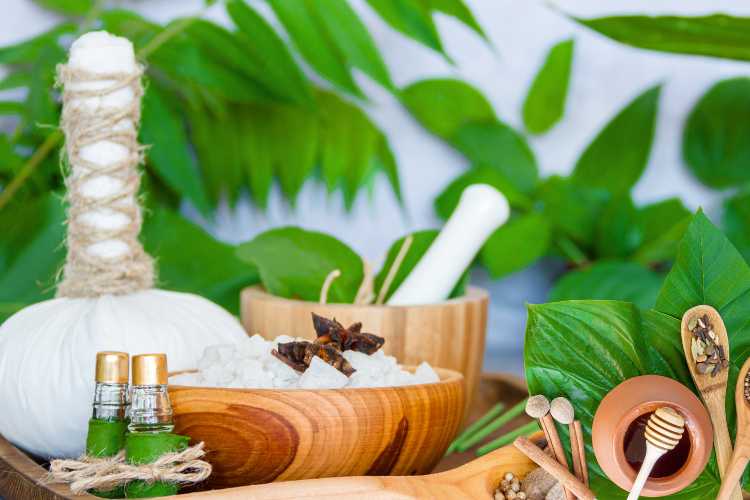Lepanam
Lepanam Ayurvedic Treatment in Coimbatore
Lepana is a traditional Ayurvedic treatment where a herbal paste is applied to the skin to heal various health conditions. The word “Lepa” means to apply or smear, and in Ayurveda, it refers to the external application of herbal medicines in paste form on the skin. Lepanam uses different types of herbal mixtures to treat diseases by applying them directly on the skin. It helps in absorbing the medicinal properties through the skin, just like modern-day creams and patches used in medicine.

Pure Herbal

Evidence Based

Guranteed Results
Lepanam Ayurvedic Treatment in Coimbatore.
If you are looking for lepanam Ayurvedic Treatment in Coimbatre Book an appointment and get free consultation.
What is Lepanam?
Lepanam is an Ayurvedic treatment where medicated herbal paste is applied on the body to reduce inflammation, pain, and swelling. The paste is made from herbs, roots, leaves, or powders, mixed with water, sour liquids like buttermilk or lemon juice, or oils. The goal of Lepanam is to soothe the body, reduce pain, and balance the doshas (especially Vata and Kapha). The paste works by entering the body through the skin, hair follicles, and sweat pores.
There are different types of Lepanam based on the thickness and temperature of the paste:
- Pradeha: Thick and usually warm paste, applied and removed after drying.
- Pralepa: Very thin and cool paste, usually used for cooling and is often removed before it dries.
- Alepa: Medium thickness paste, not too hot or cold. It can be removed after drying or left for a while.
Who is Eligible for Lepanam?
Lepanam is suitable for most people, but especially for those suffering from joint pain, muscle stiffness, arthritis, inflammation, and skin diseases. It is most effective for people with Vata and Kapha imbalances.
However, a few groups need caution:
- People with open wounds or broken skin (paste should not be applied on injured areas).
- Pregnant women (only with proper guidance).
- Infants and the elderly (the skin is more sensitive, so herbs and heat should be mild).

Which Diseases Are Treated by Lepanam?
Lepanam can help treat various conditions, particularly those associated with Vata and Kapha doshas. In conditions where there is a burning sensation or heat (Pitta imbalance), cooling herbs are used in Lepanam.
Some of the common diseases include:
- Joint pain and arthritis
- Back pain or stiffness
- Swelling and inflammation
- Frozen shoulder
- Muscle spasms or tightness
- Skin conditions like eczema or psoriasis
- Paralysis (as supportive therapy)
Dryness and stiffness in the body

Contraindications
Although Lepana is generally safe, there are certain situations where it should not be used. Avoid lepana in the following cases:
- Open wounds or broken skin
- Allergy or sensitivity to specific herbs
- Night-time application (unless advised in certain conditions, like unripe swelling)
- Very old or spoiled paste
- Herbal pastes spoil quickly and should be used within 24 hours if made from fresh herbs.
- Application on eyes, mouth, or genitals unless specifically advised
- Overlapping or repeated application without removing the previous one
- If the Lepa causes itching, burning, redness, or watery discharge, it should be stopped immediately.
- Not suitable during pregnancy or for infants without supervision.
Please Note: Applying Lepa incorrectly or using expired ingredients can harm the skin and cause reactions. Always follow proper guidelines or take advice from a trained Ayurvedic doctor.
How to Prepare the Patient for Lepanam
Before starting Lepanam, the patient and the area to be treated must be properly prepared.
- Consultation and Examination: The Ayurvedic doctor checks the person’s body type (Prakriti), current health issues (Vikriti), and strength of the disease. The affected body part is examined for any wounds or sensitivity.
- Positioning the Patient: The patient is asked to sit or lie down in a comfortable position so that the area is easily accessible. The part should be properly exposed and supported.
Preparation of Medicines: Depending on the disease and dosha involved, the proper herbs are selected. The paste is prepared fresh each time for application
Procedure of Lepanam
Making the Herbal Paste
- Herbal formulations like Kolakulathadi churna or herbs like Eranda (castor), Masha (black gram), Kola (wild jujube), and Rasna are commonly used. However, this can vary according to the condition of the patient
- These are powdered and mixed with sour substances like kanji (fermented rice water) or amla juice to make a paste.
- Sometimes medicated oils or gruels are added depending on the condition.
- The paste can be made warm or cool based on the dosha imbalance.
Application
- The paste is applied in the opposite direction of hair growth (pratiloma gati) to help better absorption.
- It is spread with a thickness of about 0.5 cm (similar to the thickness of buffalo skin, as said in Ayurvedic texts).
- The paste may be left to dry (for pain relief), or removed while still wet (for cooling or skin issues).
- For better results, the area may be covered with leaves like Eranda (castor) or banana leaf, and gently bandaged.
Duration
- Usually, the paste is left for 6 to 12 hours, depending on the season and disease.
- In summer, it is removed earlier (after 6 hours), while in winter, it can stay longer.
- Some pastes (like Upanaha Sveda) are kept overnight and removed in the morning.
Cleaning
- After removing the paste, the area is cleaned with warm water to remove any leftover paste and soothe the skin.
Types of Lepanam
- Pradeha:
A thick, usually warm herbal paste used to reduce pain and swelling. It is applied and removed once it dries. - Pralepa:
A thin, cool herbal paste, used for soothing burning or irritation. Can be removed before it dries or after drying depending on the condition. - Alepa:
A medium-thick paste that combines the benefits of both Pradeha and Pralepa. It may be hot or cold and is usually left on for a moderate amount of time. - Upanaha Sveda (Herbal Poultice Therapy):
- Warm herbal paste is applied to the body, covered with leaves, and tied with cloth.
- Usually done for joint pain, stiffness, or arthritis.
- The paste is made warm and retained for 6–12 hours.
- Anna Lepana (Rice Paste Therapy):
- A Kerala tradition where warm rice gruel is applied over specific muscles.
- Done after a full-body oil massage (Abhyanga).
- Helps in muscle wasting, burning sensation, and loss of function.
Lepana in Beauty and Hair Care
Lepas are not just for healing diseases—they are also used for beauty enhancement.
- Kesharanjana Lepa: These are special hair Lepas used for natural colouring and preventing premature greying of hair.
- Varnya Lepas: Helps in improving skin brightness, removing blemishes, and supporting a youthful appearance.
Herbal Lepas are gaining popularity in the beauty world because they are:
- Natural
- Safe
- Affordable
- Long-lasting
- Free from side effects (when used properly)
Do’s and Don’ts in Lepanam
Do’s:
- Always consult an Ayurvedic doctor before starting Lepanam.
- Use freshly prepared paste each time.
- Apply in an upward direction against the hair growth.
- Keep the area clean before and after the treatment.
- Use lukewarm water to wash the paste off.
- Apply in the daytime, not at night.
- Understand the season and the body condition before choosing the paste type.
Don’ts:
- Don’t use Lepanam over open wounds or infected skin.
- Don’t reheat or reuse old paste.
- Don’t apply paste over an old lepa (layering causes skin problems).
- Don’t keep the paste for too long, especially after it has dried.
- Don’t perform Lepanam during night hours – it may trap body heat and worsen symptoms.
- Avoid applying in cold weather without proper precautions.
Conclusion
Lepanam is a simple yet highly effective Ayurvedic treatment that uses the power of nature to heal the body through the skin. It provides quick relief from pain, stiffness, inflammation, and many joint and muscle-related problems. With the right herbs and technique, it can work wonders in balancing the body’s energies (doshas), especially Vata and Kapha.
While Lepanam is safe when performed correctly, it is essential to consult a trained Ayurvedic practitioner before commencing. Each person’s body and disease condition is unique, so the choice of herbs, paste type, temperature, and duration must be customised.
By following the correct procedure and guidelines, Lepanam can become a valuable part of natural healing and pain management, without the need for synthetic chemicals or invasive procedures.
What are you waiting for...
Book an Appointment
Hours & Contact
28A Bharathi Park 7th Cross, Saibaba Colony, Coimbatore
641043
+9142229 69555
+9189039 69555
info@avanikaayurvedic.com
Open All Days 7:00 AM -7:00 PM
